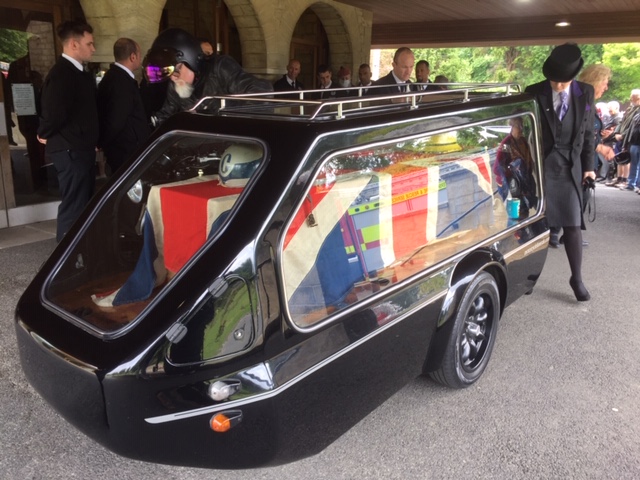One of the legends of wheelchair bowls community George Ridgeon passed a little while ago. Former Patron of the BWBA, David Rhys Jones, has written a fitting tribute below. By way of a PS, DRJ has also penned a short account of George’s funeral where he and BWBA President Ian Blackmore represented the charity.
GEORGE RIDGEON
Obituaries like this one often include the words, “There was only one so-and-so…” But, believe me, there really was only one George Ridgeon. The former fire-fighter and Isle of Man TT motor-cycle racer was paralysed in an accident while fighting a fire in November, 1981, but went on to make his mark in bowls, charity work and politics. He died peacefully at his home in Churchdown in Gloucestershire, on Easter Saturday, just a week-and-a-half after his 78th birthday.
George was 37, and in his prime, when the unsecured ladder on which he was attempting a dramatic rescue from an upper floor of a blazing house collapsed. He was taken to Stoke Mandeville Hospital, where he received the news that he would never walk again. His spinal injury was such that he had no movement below the waist, and very little above. He was a tetraplegic.
We can only imagine the drive and energy he brought to his activities as a fireman and a racer, but he needed to mine untold depths of defiant determination to respond to this horrific and life-changing event. The next forty years bear witness to his strength of character and indomitable spirit.
Yes, in those days, the Stoke Mandeville Indoor Bowls Club was based in the grounds of the hospital, which had close ties with the Stoke Mandeville Stadium. This was where Professor Sir Ludwig Guttmann, a German neurologist, pioneered the use of sport in the rehabilitation of people with spinal injuries, and where he became known as ‘the father of the Paralympic movement’.
George was duly introduced to bowls at Stoke Mandeville. And, as Patron of the British Wheelchair Bowls Association for many years, I can testify to the vigour and infectious enthusiasm he brought to our sport. Energetic, inquisitive and tenacious, he would never take no for an answer. He was a shining example, not only to people who suffer life-changing injuries, but also those of us who could be described as able-bodied.
While paraplegics, paralysed from the waist down, can and do play bowls with no concessions being made, tetraplegics, who have a high spinal lesion – and whose upper-body strength and arm movements are therefore severely affected – are normally thought to be incapable of propelling a bowl to a long jack, even on fast indoor greens, and play a limited game with carpet bowls.
Trouble is – no-one told George about this, and he was hell-bent on playing ‘proper’ bowls on equal terms with his able-bodied friends and rivals. Not only did he succeed in doing so, but, after winning para-bowls competitions, he proceeded to join various indoor bowls clubs, and went on to win the club singles title at more than one of them.
He was a popular member of the Fire Service Association bowls club, and represented them on many occasions, and he even joined the Professional Bowls Association, and competed in the play-offs for World Bowls Tour events. He was also to be seen regularly in the spectators; gallery at Potters Resort during the world indoor championships – and always attended the PBA AGM, where he often asked difficult questions.
Many in Gloucestershire will remember that George, an ardent Royalist, twice stood – or, in his case, as he himself insisted, ‘sat’ – as a candidate in General Elections under the banner of the Monster Raving Loony Party. In fact, he always claimed to fulfil a special role with the MRLP – he used to say he was their Minister of Happiness. He was also a tireless campaigner for disabled rights, and worked hard for various charities.
George had a penchant for collecting strange artefacts, and was a keen bidder at auctions. The items that he acquired that way included, would you believe, Sir Winston Churchill’s false teeth, a dress that belonged to Shirley Bassey, and various items that had been owned by Doris Day, whom he referred to as his ‘first girlfriend’.
In 2011, it was reported that George, who described himself as a War Baby, paid £33,600 for a book that contained the signatures of 107 RAF Flying Officers, who flew in World War Two’s Battle of Britain. The book was once described by Churchill as ‘Not a book of names, but a Book of Heroes’.
The George I knew would have been amused to know that, while I was researching for this feature, I came across a record of a George Ridgeon, who was convicted at Suffolk Quarter Sessions, sentenced to seven years imprisonment, and deported, with 229 other convicts, on the ship Susan, to Van Diemen’s Land (Tasmania), on 29 July, 1837. He would have loved that!
During lockdown, George was busy piecing together Part I of his autobiography, written with the help of Sue Moore. Appropriately entitled Ridgeon Rides Again, it covered the years prior to his life-changing accident. It’s a fascinating tale of one man’s rite of passage and throws interesting light on social history from his birth in 1944 through to 1981. Work on Part II had already started, and Sue is working at it as you read this. Bringing us up to date in 2022, it will include the story of George’s adventures in bowls, his flirtation with politics, and his involvement in charity work.
George made frequent appearances on radio phone-ins, airing his various obsessions and enthusiasms, but nothing sums him up better than something he did in the last few weeks of his extraordinary life. Sue Moore tells me that George instructed her to send a copy of Ridgeon Rides Again to her Majesty The Queen, with a letter that finished by telling her that once she’d read it she should pass it on to Prince William as “he knew he’d enjoy it being motorcycle enthusiast.
There was an outpouring of emotion when his death was announced on Easter Sunday, because he was a popular and well-recognised character in his home county and beyond. He was loved and respected in the world of motor-cycling, where he had many friends. But, in the world of wheelchair bowls, he was an inspirational icon – even when he was being annoying!
What a character! Yes, we knew this was coming. George himself, an avid poster on Facebook, often referred to the limited amount of time he had left. And he held a special birthday party on 31 March this year to say goodbye to his many friends. But the news still came as a shock and made us all very sad. Yes, there’s no doubt that George Ridgeon will be missed by many – but his influence will still be felt in all sorts of ways. Rest in Peace, George! You certainly made your mark!
A SIDECAR FAREWELL
Last month, we mourned the death of the inspirational, eccentric and sometimes annoying wheelchair bowls icon George Ridgeon. A few days later, his funeral service, at Gloucester Crematorium, proved to be fittingly unusual. Indeed, it was unlike any funeral I had ever attended.
First of all, the coffin containing George’s body arrived at the Crematorium in a sidecar hearse – a nod to the fact that George once raced motor-cycles in the Isle of Man TT. Two fire-engines accompanied the motor-cycle and sidecar – and a guard of honour was provided by local fire fighters.
Emotional and amusing tributes were paid by a couple of his friends, Frank Prentice and Andy Hoare – but the most extraordinary feature of the service came towards the end, when George appeared on a video screen and performed a routine, rather like a stand-up (or in his case sit-down) comedian.
In a message he had recorded especially for the occasion, he ran through the list of things that God was unwilling to allow him to take with him into the beyond, and launched into a series of doctor jokes. “The doctor said, ‘I haven’t seen you for ages!’, to which I replied, I know – I’ve been ill!’”
Thanks for that, George – and for a life full of energy, humour, dynamism and endeavour. Despite your debilitating spinal injury, you were as dedicated a bowler as I have ever met, and you never took no for an answer. You were an inspiration to us all.


